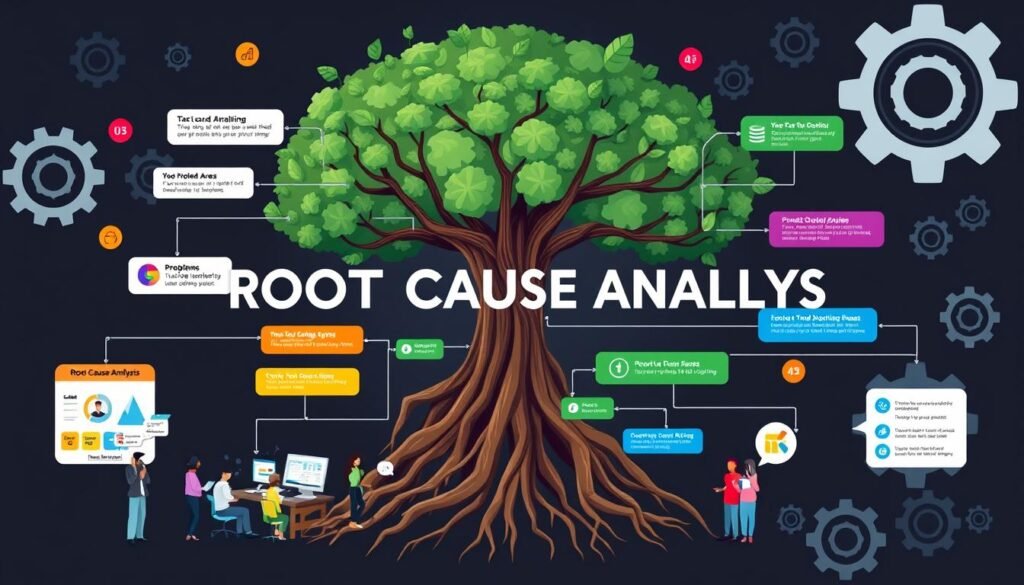Did you know that companies that actively engage in root cause analysis are 30% more effective at reducing the recurrence of problems? The significance of understanding the underlying issues behind operational challenges cannot be overstated for any organization aiming for continuous improvement. Root cause analysis (RCA) transcends being merely a problem-solving tool; it embodies a systematic approach that delves into the failings within business processes. By targeting the root cause rather than merely addressing symptoms, businesses can implement solutions that foster sustained success.
In this section, we delve into the importance of RCA in cultivating a culture of continuous improvement. We will also highlight key principles that lay the groundwork for more effective problem-solving strategies across diverse business landscapes.
Key Takeaways
- Root cause analysis is essential for identifying underlying issues.
- Effective RCA leads to lasting solutions rather than quick fixes.
- A strong focus on RCA promotes a culture of continuous improvement.
- Understanding root causes improves overall business analysis.
- Organizations that practice RCA see a reduction in recurring problems.
What is Root Cause Analysis?
Root cause analysis (RCA) represents a pivotal methodology aimed at uncovering the underlying reasons behind system defects or problems. This process is instrumental in enabling organizations to address issues with a focus on sustainable solutions, rather than mere temporary fixes. The act of identifying the root cause of a problem is pivotal, as it facilitates substantial enhancements in both performance and quality.
Definition and Importance
At its essence, root cause analysis endeavors to elucidate the genesis of a problem. Through a systematic cause analysis methodology, teams are able to concentrate on preventive measures, thereby averting the recurrence of similar issues. The significance of RCA transcends mere problem resolution; it cultivates a culture of perpetual enhancement and operational resilience.
Historical Background
The inception of root cause analysis dates back to the mid-20th century, as part of the quality control movements. Visionaries such as W. Edwards Deming and Joseph Juran were instrumental in establishing the foundational principles of effective RCA practices. Their contributions to quality management have significantly influenced the evolution of modern RCA, rendering it applicable across a broad spectrum of industries.
Why is Root Cause Analysis Essential?
Root cause analysis (RCA) is a cornerstone in the pursuit of operational excellence across diverse sectors. It enables organizations to delve into the fundamental issues precipitating problems, thereby facilitating the implementation of strategies geared towards sustained improvement.
Driving Continuous Improvement
Engagement in root cause analysis catalyzes substantial advancements in operational processes. This approach empowers teams to pinpoint the underlying causes of issues, rather than merely treating symptoms. The resultant implementation of RCA findings yields lasting solutions, enhancing productivity and cultivating a culture of continuous enhancement. Entities dedicated to this methodology often witness the evolution of more efficient operations and superior resource allocation.
Reducing Recurrence of Problems
Root cause analysis also plays a pivotal role in curtailing the recurrence of problems. Through a comprehensive understanding of problem causation, teams can devise bespoke solutions, thereby averting the emergence of analogous issues in the future. This proactive stance contributes to enhanced problem resolution and fortifies a company’s reputation. As the adoption of RCA methodologies gains traction, the emphasis remains on ensuring quality and nurturing environments that facilitate learning from past errors.
Common Methods of Root Cause Analysis
Several effective techniques assist in the process of root cause analysis. Understanding these methods can enhance troubleshooting efforts and lead to more accurate cause analysis. Below are three popular approaches commonly utilized in various industries.
The 5 Whys Technique
The 5 Whys technique is a straightforward yet powerful method for exploring the underlying causes of a problem. By repeatedly asking “why” in response to the problem statement, teams can uncover deeper issues that may initially appear unrelated. This technique encourages a thorough examination of the circumstances leading to a dilemma.
Fishbone Diagram
Often referred to as the Ishikawa diagram, the Fishbone Diagram visually lays out potential causes categorized by factors such as people, processes, materials, and equipment. This visual representation facilitates collaborative discussions during cause analysis, enabling teams to see and address various issues contributing to the problem.
Fault Tree Analysis
Fault Tree Analysis systematically maps out the failure paths that lead to undesirable outcomes. This method identifies both the necessary events and conditions required for failures to occur. By employing this structured approach, teams can pinpoint critical areas for troubleshooting, ensuring that all potential root causes are considered and analyzed.
The Role of Teams in Root Cause Analysis
The efficacy of root cause analysis is significantly bolstered by the collective endeavors of teams, comprising members from various departments. This multi-disciplinary methodology enhances the analytical process, integrating a plethora of viewpoints and specialized knowledge. Such a collaborative framework is instrumental in uncovering deeper insights and devising innovative solutions, pivotal for any successful business analysis endeavor.
Collaborative Approaches
Teamwork fosters an atmosphere where members are encouraged to share their ideas, a crucial factor in facilitating effective dialogue. The amalgamation of diverse perspectives significantly augments the detection of underlying issues. Implementing strategies such as regular brainstorming sessions or structured frameworks aids in maintaining the team’s focus during investigations. For further insights into enhancing team involvement in root cause analysis, refer to this resource.
Assigning Roles and Responsibilities
Establishing clear roles and responsibilities within the team is essential for optimizing contributions and ensuring accountability, which underpins a successful analysis. Assigning specific tasks enables team members to capitalize on their strengths, fostering a sense of ownership over the process. This structured methodology not only facilitates effective business analysis but also streamlines problem-solving efforts, as each participant is aware of their specific role in identifying root causes.
Steps in the Root Cause Analysis Process
The journey through the root cause analysis process is marked by a series of critical steps. Each step is a building block, forming a cohesive framework for tackling problems. The following are the fundamental stages of this methodology.
Identifying the Problem
The first step is paramount: clearly defining the problem. This initial phase necessitates a comprehensive grasp of the situation, ensuring uniform understanding among all team members. Misinterpretation can result in ineffective remedies and unnecessary resource expenditure.
Collecting Data
Following problem identification, the next step is data collection. This involves gathering information from diverse sources, including reports, interviews, and direct observations. The quality of data collected is crucial, as it underpins a thorough investigation, offering profound insights into the problem’s nature.
Analyzing the Causes
Subsequent to data collection, various analytical techniques are employed. The 5 Whys technique and the Fishbone Diagram are among the tools used. These methodologies facilitate a systematic exploration of the root causes, enhancing the team’s ability to dissect the issues effectively. The efficacy of this analysis is pivotal to the success of the root cause analysis.
Implementing Solutions
The final phase involves the implementation of solutions derived from the analysis. This stage is critical for preventing the recurrence of identified problems. By actively implementing solutions, the path is cleared for ongoing improvement and lasting results in future investigations.
Tools and Resources for Effective Analysis
In today’s corporate landscape, the integration of advanced tools and resources into root cause analysis processes is paramount. The deployment of sophisticated software solutions empowers teams to optimize their data collection and analysis endeavors. This, in turn, enhances the efficacy and efficiency of cause analysis, a cornerstone in business operations.
Software Solutions
Applications such as Minitab and Quality Companion stand out for their analytical prowess, specifically designed for business analysis. These platforms facilitate the manipulation of data, the identification of trends, and the visualization of outcomes. The adoption of these software solutions is instrumental in ensuring the accuracy of evaluations, thereby promoting enhanced decision-making capabilities. Such investments are pivotal in refining the analysis process, leading to substantial improvements.
Templates and Checklists
Complementing software solutions, the utilization of templates and checklists tailored for root cause analysis methodologies is equally beneficial. These structured frameworks ensure a comprehensive evaluation approach, preventing the omission of critical elements. Resources such as business analysis guides offer valuable insights into these methodologies. By incorporating these tools, organizations can streamline their efforts in identifying and addressing issues, thereby concentrating on sustained improvement.
Root Cause Analysis in Different Industries
Root cause analysis, a methodology of unparalleled versatility, permeates through various sectors, each tailoring its application to address unique challenges. This approach, through meticulous cause analysis, enables numerous industries to elevate their operational efficacy and achieve enduring problem resolution. An examination of how distinct sectors employ root cause analysis is warranted.
Manufacturing
In the manufacturing domain, root cause analysis emerges as a critical tool for defect minimization and process optimization. By pinpointing the underlying causes of production issues, entities can execute targeted corrective measures, thereby leading to:
- Enhanced product quality
- Reduced waste
- Augmented productivity
Healthcare
Healthcare entities leverage root cause analysis to bolster patient safety and elevate care quality. This methodology addresses concerns linked to medical errors, service delays, and equipment malfunctions. The application of root cause analysis in healthcare yields:
- Improved patient outcomes
- Increased staff accountability
- Streamlined operational procedures
IT and Software Development
In the IT and software development sphere, root cause analysis is indispensable for resolving system failures and bolstering software reliability. Through systematic problem identification, developers can notably enhance:
- System performance
- End-user satisfaction
- Efficiency of software applications
Challenges in Conducting Root Cause Analysis
Implementing root cause analysis within organizations often encounters numerous hurdles. These impediments can severely hinder the efficacy of problem-solving and the thoroughness of investigations into underlying issues. It is imperative to recognize and surmount these obstacles to cultivate a culture of continuous improvement.
Resistance to Change
The primary challenge in root cause analysis is resistance to change. Employees frequently exhibit reluctance to embrace new methodologies or confront past errors. This hesitation is often rooted in fear of the unknown or apprehension about the repercussions of acknowledging mistakes. Creating an environment that fosters open communication and welcomes change is crucial in overcoming this hurdle.
Lack of Data
Another formidable challenge is the lack of accurate data. Inadequate data collection methods can result in incomplete information, complicating the investigation process. Without precise and relevant data, pinpointing the root causes becomes a daunting task, potentially leading to incorrect conclusions. Therefore, organizations must prioritize the integrity and availability of data to enhance their root cause analysis capabilities.
Real-World Examples of Successful Analysis

The efficacy of root cause analysis in practical scenarios offers profound insights into its utility. Two exemplary instances underscore its transformative impact across diverse sectors, underscoring its critical role in problem resolution and business evaluation.
Case Study: Toyota Production System
The Toyota Production System (TPS) stands as a global paragon for lean manufacturing, its success predicated on the elimination of waste through root cause analysis. By methodically uncovering inefficiencies, Toyota has refined its processes, ensuring perpetual enhancement. The incorporation of RCA not only boosts productivity but also cultivates a culture of excellence, highlighting the significance of exhaustive business analysis.
Case Study: NASA’s Space Shuttle Program
NASA’s Space Shuttle Program exemplifies the successful application of root cause analysis. This ambitious endeavor demanded unwavering commitment to safety and dependability. Each mission’s challenges were thoroughly dissected to pinpoint underlying causes. This meticulous approach guaranteed the effective rectification of issues, facilitating the progression towards safer future endeavors. The case vividly demonstrates the indispensable role of comprehensive RCA in high-risk environments.
To gain a deeper understanding of analogous instances across various sectors, examining additional successful root cause analysis endeavors can offer invaluable perspectives.
Measuring the Effectiveness of Root Cause Analysis
Assessing the efficacy of root cause analysis is paramount for entities aiming at perpetual enhancement. The establishment of precise key performance indicators (KPIs) is crucial for evaluating the efficacy of the solutions deployed. These KPIs offer critical insights into the overarching outcomes derived from business analysis endeavors.
Key Performance Indicators (KPIs)
KPIs represent quantifiable metrics that delineate an organization’s attainment of its pivotal objectives. It is imperative to consider the following KPIs:
- Reduction in defect rates
- Time taken to resolve issues
- Employee engagement in the root cause analysis process
- Cost savings from implemented solutions
Through the surveillance of these metrics, corporations can gauge the immediate repercussions of their root cause analysis initiatives.
Continuous Monitoring
The perpetual surveillance of the stipulated KPIs cultivates an ambiance conducive to the identification of areas necessitating enhancement. An incessant examination of performance metrics ensures that entities remain nimble and adaptable to evolving scenarios. The refinement of processes based on immediate feedback nurtures a culture that prioritizes continuous improvement, thereby augmenting the efficacy of root cause analysis.
Best Practices for Root Cause Analysis
Adopting best practices is pivotal in elevating the efficacy of root cause analysis. Teams engaged in problem-solving benefit from a methodical approach. This approach necessitates open dialogue among team members and meticulous documentation of the investigative process.
Encouraging Open Communication
Creating a culture that values open communication is essential. It empowers team members to share their insights and voice concerns freely. This openness facilitates the precise identification of root causes during investigations. Discussions should aim to integrate diverse perspectives, ensuring a comprehensive understanding of underlying issues.
Documenting the Process
Documenting each phase of the root cause analysis is vital for creating a repository of knowledge. This repository is invaluable for future investigations. Maintaining detailed records of findings, methodologies, and outcomes enhances consistency. It also ensures that lessons learned from each analysis are retained. Standardized procedures and checklists streamline efforts, leading to more efficient and thorough evaluations of problems.
Training and Development for Teams

Arming teams with the appropriate competencies is paramount for proficient root cause analysis. A commitment to training and development cultivates an environment where problem-solving and troubleshooting are instinctual. Through workshops, seminars, and other educational tools, team members’ capabilities are significantly bolstered, empowering them to confront challenges with assurance and acumen.
Essential Skills for Team Members
Team members must develop specific competencies to ensure their efficacy in root cause analysis. Critical skills include:
- Analytical Thinking: The capacity to dissect intricate problems methodically.
- Communication: The ability to disseminate information and facilitate dialogue fosters a profound comprehension.
- Collaboration: Engaging with varied groups enriches perspectives during problem-solving endeavors.
- Technical Proficiency: Acquaintance with tools and methodologies employed in troubleshooting is indispensable.
Workshops and Training Resources
Organizations must prioritize continuous education for their teams. Workshops provide practical experiences where members can hone methodologies in real scenarios. Furthermore, training resources such as online courses, manuals, and case studies furnish individuals with applicable knowledge. Regular training instills a proactive attitude, vital for sustained enhancement in root cause analysis.
The Future of Root Cause Analysis
As entities pursue perpetual enhancement, the trajectory of root cause analysis is poised for profound transformation. The advent of cutting-edge technologies heralds a new era. The incorporation of artificial intelligence and machine learning into data-driven cause analysis is becoming prevalent. This development not only augments the precision of outcomes but also optimizes the efficiency in uncovering root causes.
Trends and Innovations
Adopting innovations is imperative for entities to remain at the forefront of business analysis. Several trends stand out:
- Predictive Analytics: Employing data to anticipate potential issues before they arise.
- Increased Collaboration: Cloud-based platforms enable effortless communication, fostering effective teamwork in real-time.
- Automated Reporting: Simplifying report creation accelerates the analysis process, enhancing clarity.
Integrating Technology
The integration of technology into root cause analysis revolutionizes traditional methodologies. Businesses can leverage techniques that facilitate:
- Real-time data collection: Capturing information as it happens boosts responsiveness.
- Visualization tools: Employing diagrams and charts to elucidate intricate data relationships.
- AI-driven insights: Machine learning algorithms reveal patterns that manual analyses might overlook.
These innovations catalyze enhanced problem-solving capabilities and drive operational efficiencies. Entities aiming to refine their root cause analysis methodologies can access valuable resources and expert advice on business analysis websites.
Conclusion: The Path Toward Problem-Solving
The significance of root cause analysis in achieving operational excellence is undeniable, transcending various sectors. This methodology, by systematically identifying and addressing the root causes of issues, significantly enhances organizational processes. It drives continuous improvement, minimizing future problem occurrences and cultivating a culture of learning and adaptation.
Implementing root cause analysis offers more than immediate solutions; it lays the groundwork for sustained performance and growth. Teams adopting these practices are adept at addressing challenges head-on, optimizing their workflows and solutions. This dedication to root cause analysis can elevate an organization to a pinnacle of efficiency.
Summary of Benefits
Organizations should integrate root cause analysis into their operational strategies to fully leverage its potential. Encouraging employees to adopt this methodology fosters a culture of inquiry and accountability, leading to enhanced performance. Embark on the journey towards meaningful problem resolution by exploring effective practices in root cause analysis and witness its transformative impact on your organization.
Encouragement to Start Analyzing
Integrating root cause analysis into daily operations is essential for teams striving for lasting success. By prioritizing this analytical approach, companies can not only resolve current issues but also lay the groundwork for future innovations and improvements. Commit to incorporating these techniques into your processes and observe the profound effects of a dedicated commitment to continuous improvement.
